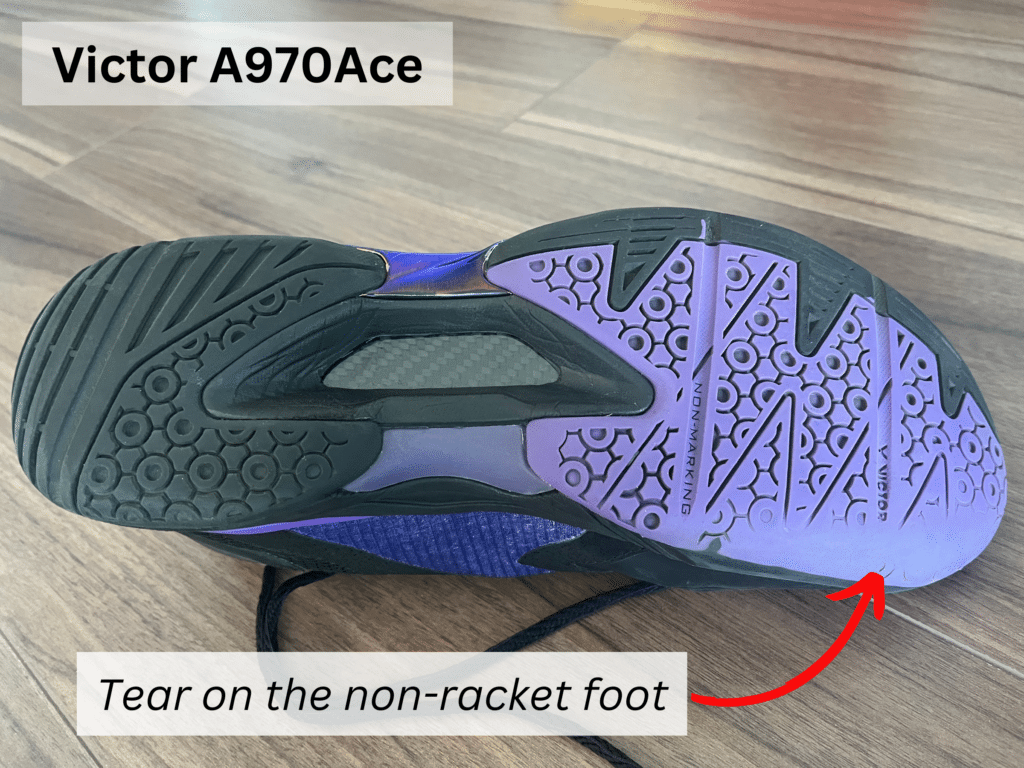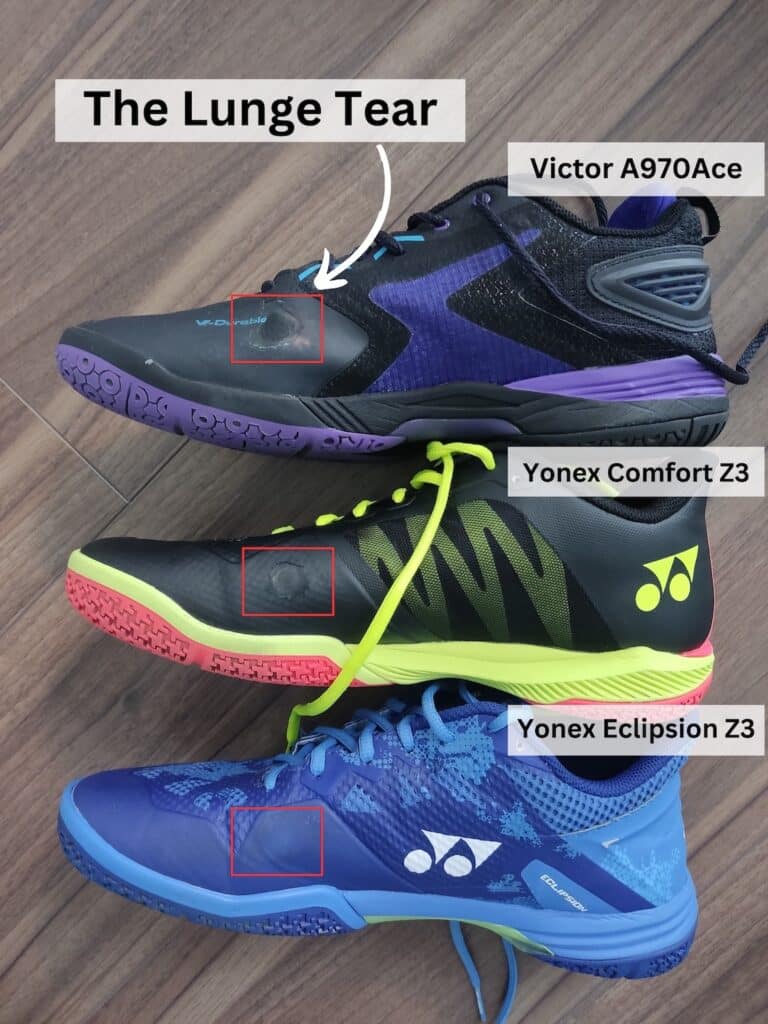The other day I was playing on a dusty court and nearly slipped as the badminton shoe grip on my lower heel felt strange.
If you’ve ever slipped on court, you know it isn’t just the actual slip and risk of injury that’s an issue. It’s also the concern of slipping again that lingers in the back of your mind for the rest of the game.
It’s the kryptonite of many badminton players and an antidote to playing freely and with confidence. A good grip allows you to forget about slipping and just play.
This article is dedicated to maintaining your existing badminton shoes, and I’ll share ideas to improve your badminton shoe grip in particular. But since I’ve tested a bunch of flagship badminton shoes, let’s begin by looking at which ones have the best grip at the moment.
The best badminton shoe grip
While I’ve tested several shoes, I haven’t been through all the options out there, so keep that in mind.
Among the most popular badminton brands, Yonex, Li-Ning, and Victor, I’ve found Yonex’s radial blade sole outsole grip to be marginally better as it feels more gluey. This is found on their flagship shoes such as the popular SHB65z3, Comfort Z3, and Eclipsion Z3.
Take note of the number three in their names as that represents the third generation. That’s important as you’ll sometimes find older models available with Yonex’s older and less-exciting grip.
I’ve found Mizuno’s Wave Claw 3 (the brand new model of H.S. Prannoy’s former shoe) to be in that same gluey category, but neither is so much better that it’s worth switching just for the grip.
To give you an easier overview, here’s an outsole comparison of one flagship shoe from each of those brands. Unless you’re geeking out on this like me, there’s probably no reason for you to remember what they look like except when you’re buying new shoes.

Badminton stores often have deals on older flagship models they want to get rid of, so be aware of what you’re buying if you’re prioritizing the best grip for your game.
To build on that, I’ve noticed discussions on whether the court surface matters for your shoe’s grip in badminton.
I’ve played on wooden floors in multi-sports complexes and several different types of badminton mats, but only noticed small differences and certainly not something that I couldn’t adapt to within a game.
I also haven’t noticed any one style of outsole grip being better for certain floors than others, but, granted, I’ve only tested a few models across different floors so this isn’t a perfect science experiment.
At the same time, I’ve also noticed some theories on whether colored outsoles make for a different grip. When comparing Yonex’s 65z3 (normal outsole color) with Comfort Z3 and Eclipsion Z3 (both have colored outsoles), I didn’t notice any difference in the grip. There were some differences in the feel of the outsole, but that was due to the shape of the lower heel rather than the grip of the outsole itself.
Now, getting new shoes is one thing. Another is reviving the grip on your existing shoes.
Ideas to make badminton shoes grip better
There are things you can do with both the outsole and insole to make your shoes more grippy.
First, let’s look at your options for improving the outsole grip. The simplest thing you can do is to avoid wearing your shoes outside or anywhere dirty as the outsole is sensitive and will pick up gravel easily.
Not only do you mess up the grip on your own shoes, but you’ll be dragging the dirt on court and messing up other players’ shoes too. This is why many players wear flip-flops to and from the court – if you’re looking for some, I’m using some that are similar to these (as an Amazon affiliate, I earn from qualifying purchases).
On the other hand, if you’re good at avoiding these but find yourself playing on a dirty court, consider placing a moist (but not overly wet) towel next to the court and stepping on it between rallies or games.
If you’re unable to get a towel, you can also slide one shoe against the other or even use your hand to wipe off the outsole. I’ve found it less effective than the towel above, though.
It’s also worth checking the area near the front and side of your non-racket foot as it gets worn out from sliding while doing lunges. I’ve found the Victor shoes I’ve tested to be less durable in this area compared to Yonex shoes.

On the other hand, if you find your feet moving within the shoe, you might be able to solve it by replacing the insole.
If you’re sure that you’re using the correct size, another option can be to get a new pair of shoes with Victor’s new drop-in midsole as the slide resistance between the insole and the foot is great (as I describe in my review of their P9200III).
Since you’re interested in prolonging your badminton shoe grip, I figure you’re also interested in other aspects of extending the lifespan of your shoes. Let’s look at that next.
Two simple tips for extending your badminton shoe’s lifespan
The thing with shoe durability and shoe maintenance is that most of the time it has to be planned and prepared in advance. When your shoes are falling apart, it’s too late.
In most cases I’ve experienced that, like with the best shuttles, flagship shoes tend to outlast budget shoes by more than the price difference. Meaning that budget shoes might last, say, six months (with peak condition being even shorter) whereas you might be able to stretch flagship shoes to last more than a year (with peak condition being 6-9 months playing a few times a week).
Even if you can get two budget shoes for the price of every one flagship when it comes to durability, the flagship shoes tend to offer better protection for your body which you’ll then essentially get for free. Of course, it’s more complex than that as lightweight performance-based shoes tend to wear out faster than supportive shoes.
Having two pairs of shoes to rotate between appears to increase the lifespan as they’ll get a breather, similar to how taking a break from sports once or twice per tweak for your body to heal is probably a good thing. I’m saying ‘appears’ since I don’t have any hard scientific test results to prove this, only my experience testing shoes.
Finally, badminton shoe advertising tends to suggest that this brand’s shoes improve your footwork. I have not come across a pair that actually does that, instead, I’ve found that improving your footwork habits can extend the life of your shoes.
For example, lunging deep to retrieve difficult shots in defense can put a strain on the inside of your non-racket foot, something I’ve named The Lunge Tear.

If you’re able to develop your lunge technique better, you can lessen that, or if you’re able to avoid having to lunge in the first place, that helps too.